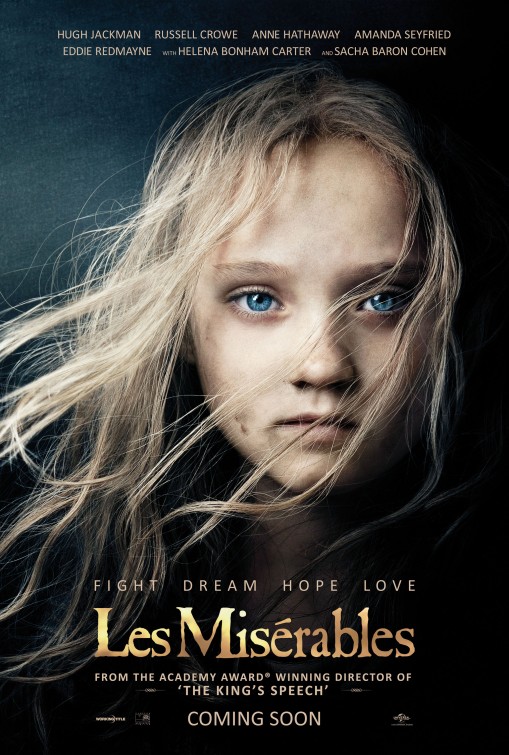 These days it is not often that film and opera cross paths, and this is not by some ancient magic: at their best the two are largely incompatible mediums. No live form uses the constraints and advantages of audience distance and persistent space quite like opera, which turns narrative into musical form and emotion into grand-sung spectacle. Even when projected two-stories high and shot with the widest lens, the walls of the cinematic frame bring an inherent editorial intimacy that doesn’t quite jibe with capital-O opera. Obviously the two have met, and at times the results have been fabulous. With his post-Academy Award, blank check adaptation of the 10,000 performance strong theatrical institution Les Misérables though, Tom Hooper has made big, venturous decisions that seek to turn great opera into great cinema.
These days it is not often that film and opera cross paths, and this is not by some ancient magic: at their best the two are largely incompatible mediums. No live form uses the constraints and advantages of audience distance and persistent space quite like opera, which turns narrative into musical form and emotion into grand-sung spectacle. Even when projected two-stories high and shot with the widest lens, the walls of the cinematic frame bring an inherent editorial intimacy that doesn’t quite jibe with capital-O opera. Obviously the two have met, and at times the results have been fabulous. With his post-Academy Award, blank check adaptation of the 10,000 performance strong theatrical institution Les Misérables though, Tom Hooper has made big, venturous decisions that seek to turn great opera into great cinema.
He has in very large part succeeded.
With such striking choices made at every level, it’s not a film that will work –or, apparently, even function– for every viewer. But for those with whom Tom Hooper’s Les Misérables connects, it will be the most grand experience one could have in a movie theater this year. A sweeping spectacle that vividly soars through the musical adaptation of Victor Hugo’s masterwork, this film is alive with passion, misery, love and revolution. The film also plays confidently on its own cinematic stage- no familiarity with the global phenomenon is demanded of its viewers, nor does it coast on the strength of its source material for its merits. Uniquely filmic accomplishments are littered throughout.
On the point of adaptation, I’m happy to reiterate that it is successful independently of its source material. All confidence on that subject comes from my experience of walking into the theater with little or no familiarity with Les Misérables, save for the vague memories of attending a Broadway performance when I was no older than the child Cosette that adorns the film’s posters. Aside from a few character names and the expectation of a revolution breaking out at some point, I brought nothing of the story with me.
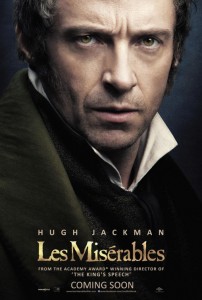
Despite a dense 157 minutes runtime the shadow of abridgment is impossible to ignore, but even truncated the story of the convict-turned-near-saint Jean Valjean is an epic one. As Valjean turns his life around and the film jumps near-decades through time and expedites character beats, the flowing music and naked emotional outpouring maintain the audience’s investment. We’re often expected to meet and empathize with major characters within very short stretches of screen time, but even without the benefit of familiarity with this world Valjean, Javert, Fantine, Cosette, Marius, and the Thènardiers play as instantly iconic. It’s the result of a strong script, brilliant performances, and keen direction working in exhilarating concert, not to mention the power of some of the most famous musical tunes of all time.
But what of the form? This is a film that chooses to broadcast at a specific wavelength in order to achieve something greater than run-of-the-mill adaptation, and there is a tone, a rhythm, a grammar to become accustomed to. In the face of the aforementioned paradox of form, Hooper chooses to go all in on the cinematic and everything it implies: intimacy and editorialism. Hooper has proven himself to be a visually distinct director, and his work here is at times more bold and yet almost always more mature than ever before. Dialogue exchanges and soliloquies are captured with the handheld wides that he loves so much, intercut with shamelessly extended close ups. Whereas a Broadway performance would consist of climactic, space-filling vibratos, to see this film in its native setting is to watch a play of space-filling visages. Often fixating on performances in extreme close-ups that rarely or never cut away, Hooper replaces the open spectacle of opera with the spectacle of monumental human faces. This, along with the much ballyhooed on-set recording of the vocal performances, allows the director and his cast to go for small and emotive more often than booming. The choice is ostentatious, it sometimes offers no chance to blink or breathe, and it resolutely reforms this material into something that is uniquely cinema.
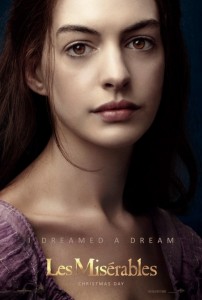
Empowering this decision is a cast that is uniformly good, if not uniformly great. Hugh Jackman clenches his ass and stretches his eyebrows enough to make every note, if sometimes just so. Russell Crowe does not dig as deep, but turns in a string of vocals that stay on the rails, too often at awkward registers. Both men are such powerful performers that their characters hit every note beautifully, even when their voices don’t. Jackman in particular delivers a leading man performance that anchors this entire epic, and he does so with all the monumental strength Jean Valjean is legendary for possessing.
It is from Hathaway and Redmayne that some of the most spectacular musical moments spring forth, as both possess true command of their singing voices. With their singing so effortless, both manage moments of performance –captured in the aforementioned uncutting close-ups– that border on sublime. It is in these moments that Opera and Cinema collider and all of Hooper’s intentions are illuminated and decisions justified- millions of other people’s dollars and three of your hours made fully worth it.
Coming in all across the spectrum from there are performances from Amanda Seyfried, Sacha Baron Cohen, Helena Bonham Carter, Samantha Barks, Isabelle Allen and Daniel Huttlestone that are varyingly effective. Cohen and Carter are a deliciously despicable pair, and the initial Thènardier sequence injects the film with its first signs of humor (though pitch black), which effectively curdles into a nasty undercurrent of cruelty throughout the rest of the film. I understand even the despicableness of the characters here represents some sanitization of the source material, though they function here as a welcome tonal balance that, again, still ends up matching the spirit of the whole.
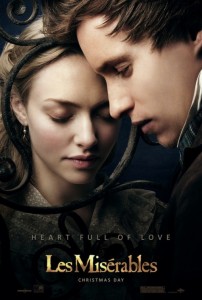 The film uses a scoring technique that –save for a few trivial previous examples– is unprecedented for a film of this scale, and had the actors doing their singing on set and in the moment, with music recomposed around them afterwards. This empowered the more intimate, emotionally improvisational vocal performances, while also providing a very different audience experience. There is likely a curve for most people to get past, but it’s worth reiterating that repeated moments of true gorgeousness justify the unusual approach. The score is triumphant and reactively tailored to the performances- bringing a unique aspect of theater to film, even enhancing it. Not only does the score speed up, slow down, and otherwise mold around the singers, it is all based on material from a take-based environment in which actors were able to find and craft their best performances over repeated tries. The best of both worlds, in simpler terms.
The film uses a scoring technique that –save for a few trivial previous examples– is unprecedented for a film of this scale, and had the actors doing their singing on set and in the moment, with music recomposed around them afterwards. This empowered the more intimate, emotionally improvisational vocal performances, while also providing a very different audience experience. There is likely a curve for most people to get past, but it’s worth reiterating that repeated moments of true gorgeousness justify the unusual approach. The score is triumphant and reactively tailored to the performances- bringing a unique aspect of theater to film, even enhancing it. Not only does the score speed up, slow down, and otherwise mold around the singers, it is all based on material from a take-based environment in which actors were able to find and craft their best performances over repeated tries. The best of both worlds, in simpler terms.
For Hooper’s part, his camera is actually restrained relative to his work on John Adams or even The King’s Speech, with him most frequently shooting scenes in a perfectly straightforward style, but sparing no visual expense in transitions that soar over cities, down into spaces, and land in closeups. The aforementioned handheld wide shots are present, and there are the occasional dutch angles and painterly compositions in which backgrounds overwhelm cropped figures. They are not to everyone’s taste, but they bring a richness to the story, and I can count on one hand the number of times a shot’s ostentatiousness overshadowed its content. Even in such cases the purpose of, say, a shot questionably canted almost 90˚ in the moments before a character rights his ultimate wrong is not difficult to discern. Frankly it’s a matter of subjective taste, as easily enjoyed and defended as a rich, energetic and dynamic approach to dramatic filmmaking as it is deplored for being too… something. Not counting myself among the detractors, I respectfully can’t quite empathize with the narrowed palette that rejects it.
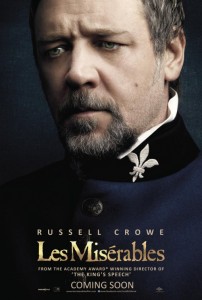
In terms of filmmaking those extended closeups are an inarguably distinctive characteristic of the film, but they demonstrate an earned faith in the material and the performers. Some of these shots are literally minutes long –interminable if you find yourself hating them, certainly– but in some cases the performances are so extraordinary that it would be an act of hubris to cut away. You’ve never seen nor heard anything quite like this in a movie musical.
The film is a striking one, from the nighttime balconies overlooking Paris to the daytime studio-lot style exteriors. As the story careens towards revolution, there is a proportional shift to more theatrical sets, but overall the film coheres as one that widens to city scale and tightens to facial intimacy like waxing and waning tides, all as it spans decades and hundreds of miles.
Tom Hooper’s Les Misérables has and earns epic sensibilities, fully carrying on the show’s tradition of feeling like an almost Biblically timeless tale. One of the ultimate stories. Fearless in technique, performance, and scale, the film claims its place among the all-time musicals and upholds the reputation of a show that has enraptured millions.
Rating: 




Out of a Possible 5 Stars